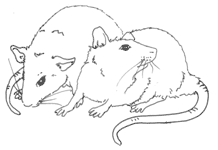Rats: General Information

See also:
 Books on rodents, including rats Books on rodents, including rats
 News and Research, rabbits and rodents News and Research, rabbits and rodents
Fancy rats live for between two and four years. They are descended from
brown rats, and may appeal to teenagers precisely because older people sometimes
find rats repugnant! Both tame and wild rats can cause a lot of damage, because
they can climb up and get into the most unlikely places, and then chew whatever
they find there. Wild rats can also spread disease, but domesticated rats
kept in nice clean cages are intelligent, rewarding pets, if cared for and
supervised properly. Children may find them more fun than guinea pigs, because
rats form stronger bonds with their owners. Most of the advice below also
applies to mice, though mice are more timid than rats, and need less room.
You can find reviews of books on rats in 'Books on Animals'
Housing
Rats need to be kept in a chew-proof cage which is as large as possible, because they are very active. A large aquarium with a top is suitable. Give them branches, platforms, and something to chew on, as well as toys, like small balls, to entertain them. They also need a nest box to hide in. You can use wood shavings as bedding - though not cedar shavings, which are not suitable for any rodent. You need to clean out all the bedding once a week, and the toilet area every day. Rats prefer to live with another rat, so they can groom and play with each other, so it's best to buy two young ones together. Two adults that don't know each other may fight, though you can try gradual introductions, as described in 'Gerbils'.
Feeding
Rats will eat just about anything, but you need to restrict their consumption of human food, so they don't get digestive problems. Rats will do well on similar seed mixes to hamsters and gerbils, with a little fresh fruit or vegetables. Always remove uneaten fresh food after a day. Rats may also be partial to grubs and insects.
Health
Prevention is better than cure - rats are more likely to stay healthy if their cages are clean, they are not exposed to big temperature fluctuations, and they do not indulge in human junk food! Seek advice from a vet if your rat has snuffles that it does not shake off - and avoid buying any rat with respiratory problems, or one that just looks 'under the weather', however handsome it may be. You want a rat that looks lively. Check out its rear end for evidence of tummy upsets, and its breathing and nose for snuffles. It's safer to quarantine new rats in a separate room from your existing pet rats for a couple of weeks, washing your hands after handling them, so you don't introduce respiratory or other infections.
Handling
Rats are curious, and make friends with their owners, but still need some respect. Give your new rat a chance to get used to his cage when you take him home, and just let him sniff and explore your hand, before picking him up. You can use titbits to tame your rat, and call him by his name when you give him a titbit, so that he's more likely to come to you when called. Rats are less likely to get lost in the house if they are kept in the same room, and know the room well enough to go back to the safety of their cage. Always supervise your rat's explorations, and make a loud noise if he starts to do something he shouldn't. Rats can be trained to perform various tasks, through rewarding them with their favourite foods. It's a good idea to handle baby rats from when they are two weeks old, because they are more easily tamed when young.
Breeding
A good time to start breeding from a female rat is at around four months old. She may not be mature enough beforehand. Giving birth may be more difficult for her if she has a first litter much after five months, and older rats have fewer pups. The gestation period lasts between 21 and 23 days and on average there are from eight to twelve in the litter, sometimes more. The pups are born blind and hairless, and their eyes open at two weeks. They are weaned at four weeks. Separate them from the mother at five weeks due to the risk of their breeding with each other or with the mother. You also need to remove the male as soon as you think the female is pregnant, due to the risk of her breeding again just after the pups are born. Always make sure you can find homes for pups before you breed from your rats - they can have very large litters!
 Top of page Top of page
See also:
 Books on rodents, including rats Books on rodents, including rats
 News and Research, rabbits and rodents News and Research, rabbits and rodents
|